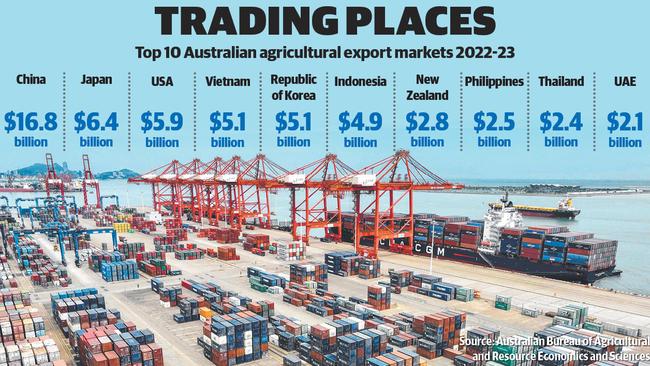Beijing bans lead to trade diversification riches
As the PM travels to Indonesia to grow trade with our near neighbours, the positive side of China’s stunning tariffs can now be appreciated.
When China slammed its doors on several key Australian agricultural commodities three years ago, blindsided farmers were forced to help grow new markets as well as food and fibre.
Finalising the United Kingdom-Australia free trade deal was the obvious first target, followed by a wishlist that included opening new routes into Europe and maturing ASEAN economies, along with countries freshly removed from the too-hard basket.
The first seeds of diplomacy sprouted deals that bloomed into 107 new market access points, worth a potential $5.47 billion last year, helping agriculture reach $92bn production gross value in 2022-23.
According to ABARES, about $80 billion worth of agricultural products were exported in 2022-23, with China remaining the largest single export market with $16.8bn, Japan was next at $6.4bn and the US third with $5.9bn.
ASEAN nations accepted around $15bn of goods and the UAE $2.1bn.

Wheat, beef, canola, cotton and sheep meat were the highest exported commodities.
Agriculture Minister Murray Watt said the first half of 2023 had continued the trend during a “very exciting time” for an industry eyeing “vast untapped potential” in new, improved, maintained and restored markets “we have not taken full advantage of yet”. Latin America holds unrealised potential for oilseeds, malt and other grains, with Chile added to the Comprehensive and Progressive Agreement for trans-Pacific Partnership in February, while crop farmers are also leveraging growing demand for feed grains in nations like Vietnam. GrainGrowers chief executive Shona Gawel said just as producers diversified planting rotations, “it is good business” to seek out new markets while maintaining longstanding relationships.
“The resilience shown by Australia in the face of Chinese tariffs is a key example of the value of diversification in mitigating risk,” she said.
“While losing our biggest market undoubtedly impacted Australian barley prices, the long-term investment into market expansion enabled a pivot to new markets such as Mexico.”
MARKET PIVOTS
The China tariff crisis exposed a volatility in Australia’s largest trading partner that continues to worry farm leaders – but also woke an agriculture industry that had arguably become too economically dependent on too few markets.
In forging new supply links, products began landing straight on plates in new countries, such as sea food in Israel and duck meat in Thailand, while raw cotton is now spinning in Pakistan’s cotton mills.

Meanwhile, the first shipment of raw sugar has been received in a $75m market under the recently signed UK free trade deal, which also improved access for dairy, seafood and meat.
Also on the menu is dairy into Chile, baby formula to the US and doubling of poultry meat exports to Singapore after import processes were streamlined last year.
Australia has also become the world’s largest goat meat exporter, with China surging in recent months to become our third biggest customer taking 23 per cent or $67m of Australian goat meat exports only behind the US (35 per cent) and Korea (25 per cent).
Rabobank believes South-East Asia a “bright spot” for dairy exporters in the medium term.
However, while industry celebrated the recent lifting of 80 per cent barley tariffs by Beijing and the government confident the 220 per cent tax slapped on wine will soon follow, it also presents a quandary.

IS INDIA THE NEW CHINA?
Australian Grape and Wine chief executive Lee McLean understands winemakers wanting to rush back into China, but maintains a wider range of export destinations will help shield the sector from future shocks.
He said Australian wine is now exported to over 100 nations in varying quantities.
“At our peak, the trade with China was worth $1.2bn. The next two markets were the US and UK at less than $500m,” he said.
“We have good relationships built over decades in China. But we also need to keep the foot on the diversification accelerator because we want to be a much more resilient industry.”
China is also currently on the edge of financial collapse, with the nation sliding into deflation and exports and retail sales slowing.
Federal Treasurer Jim Chalmers on April 26 said the softness was “concerning” given its “obvious implications” for Australia.
Along with diversification, another word on industry lips is India, which recently reduced tariffs and opened access on a range of Australian berries, nuts, vegetables, protein and wool into a export market already worth $20 billion a year to the national economy.
Avocados Australia chief executive John Tyas said in March the industry’s entry was a “game changer” and Mr Watt accompanied a delegation of 10 agriculture industry leaders on a mission to the emerging economic superpower – with a growing middle class primed for Australian premium products – in July.
In what may become a regular approach, the unity ticket will help position Australia as a key supplier across commodities, to negotiate compliance and regulatory burdens and navigate market access as agricultural nationalism and global trade becomes increasingly complex.
“We cannot put all our eggs in the one basket. Where we can develop new, big, valuable markets we should be doing so,” Mr Watt said.

Sheep Producers Australia chief executive Bonnie Skinner said eliminating tariffs opened access to India’s immense food service channels.
She said other recent deals with the UK, China, Indonesia and Korea provided sheep farmers not only access to “high-consumption growth markets” but also reduced the risks of “being overly reliant on any one buyer.”
Meanwhile, Trade Minister Don Farrell met with European Union counterpart Valdis
Dombrovskis last Thursday to reignite talks in a bid to finalise an EU trade deal.

Following the meeting, Mr Farrell said progress had been made, “but we need to bridge the gap between our expectations, and what the Europeans are offering.”
“I am prepared to persist for as long as it takes, and to work as hard as I can on behalf of Australian producers and businesses, to get a better deal,” he said.
Prime Minister Anthony Albanese on Wednesday travelled to Jakarta to launch the Southeast Asian Economic Strategy at the ASEAN Indo-Pacific Forum.
The strategy aims to grow two-way trade with the region by $534bn by 2040 with agriculture identified as one of the priority sector targets.




